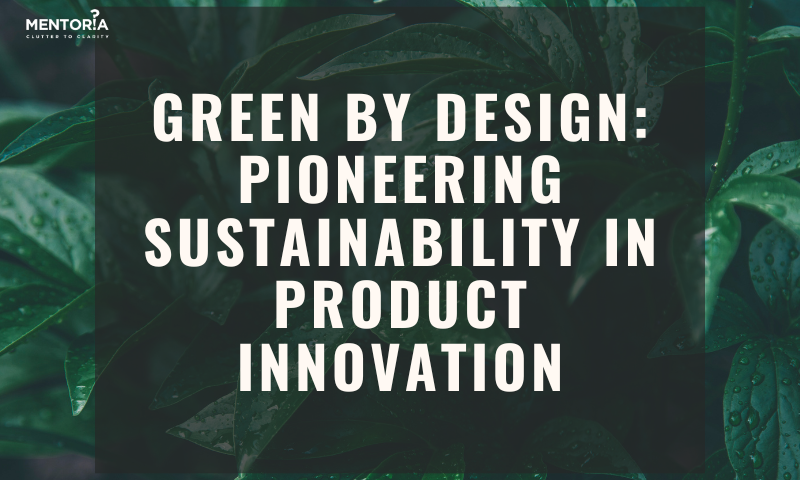Green By Design: Pioneering Sustainability In Product Innovation

Jump to Section
In an era defined by mounting environmental concerns, product designers have taken centre stage in the pursuit of sustainable solutions. As the urgency to reduce our ecological footprint intensifies, innovations in product design have become a crucial avenue for addressing sustainability challenges. From eco-friendly materials to energy-efficient technologies, designers are revolutionising the way we create and interact with everyday objects. This blog delves into the realm of sustainable design, exploring groundbreaking ideas and transformative approaches that are shaping a greener future. Get ready to be inspired, informed, and motivated to make eco-conscious choices in your everyday life.
Biomimicry: Nature As A Design Guru
Mother Nature has been perfecting designs for billions of years, and it’s time we took a leaf out of her book. Biomimicry is an approach that draws inspiration from the natural world to solve human challenges sustainably. Designers are studying the structural integrity of leaves, the water-repelling properties of lotus leaves, and the efficiency of honeybee colonies to create innovative and sustainable products. From self-cleaning surfaces to energy-efficient building designs, biomimicry is changing the game by merging nature’s wisdom with human ingenuity. For example, the design of the V-tail design of the Boeing 787 Dreamliner was inspired by the wing shape of the humpback whale. This design has made the Dreamliner more fuel-efficient, reducing its environmental impact
Cradle To Cradle Design: Closing The Loop
In a linear economy, products have a short lifespan and end up in landfills, contributing to pollution and resource depletion. Cradle to Cradle design flips the script by focusing on the circular economy. It aims to create products that can be continuously recycled or repurposed at the end of their life cycle. Designers are embracing materials that can be easily disassembled, sorted, and recycled. They’re also exploring innovative materials like bioplastics made from renewable sources and bio fabricated materials that mimic animal products without the environmental impact. Cradle to Cradle design ensures that every product becomes a valuable resource, reducing waste and preserving natural resources. This approach has been used to create products such as the T-shirt made from recycled plastic bottles and the laptop made from recycled aluminum.
Minimalism: Less Is More
In a world obsessed with consumerism, minimalism brings a breath of fresh air. Designers are adopting a less-is-more approach, focusing on creating products that are functional, durable, and timeless. By designing products that are built to last, we reduce the need for constant replacements and minimise waste. From sleek, multipurpose furniture to minimalist electronic gadgets, the mantra of “less is more” is transforming product design. Embracing minimalism not only reduces our environmental footprint but also promotes a clutter-free lifestyle and fosters a sense of mindfulness. For example, the company Everlane designs minimalist clothing that is made from sustainable materials.
Sustainable Materials: From Trash To Treasure
The global market for sustainable products is expected to reach $12.3 trillion by 2030. One person’s trash is another person’s treasure, and this holds true in the world of sustainable product design. Designers are exploring unconventional materials and transforming waste into valuable resources. From upcycled plastics and reclaimed wood to recycled textiles and ocean plastic, sustainable materials are revolutionising the industry. By diverting waste from landfills and reducing the demand for virgin resources, designers are paving the way for a more sustainable future. For example, the company Patagonia uses recycled plastic bottles to make its fleece jackets. In fact, the number of consumers who are willing to pay more for sustainable products has increased by 50% in the past five years.
Smart Technology: Energy Efficiency At Your Fingertips
Advancements in smart technology have opened up new avenues for sustainable product design. From energy-efficient appliances to smart home systems that optimise energy consumption, technology is driving a green revolution. Smart devices can monitor and adjust energy usage, reduce water waste, and optimise resource efficiency. Imagine a home that learns your preferences and adjusts lighting and temperature accordingly, or a smartphone app that helps you track and reduce your energy consumption. With smart technology, sustainability becomes convenient, accessible, and fun.
Collaborative Consumption: Sharing Is Caring
The rise of the sharing economy has transformed the way we think about ownership. Collaborative consumption promotes the idea of sharing resources and products instead of owning them individually. Designers are creating platforms and products that facilitate sharing and community engagement. From shared workspaces to car-sharing platforms and tool libraries, collaborative consumption fosters sustainability by maximising resource utilisation and reducing waste. By encouraging sharing and communal ownership, we can achieve more with less and build stronger, more connected communities. For example, the company Zipcar allows users to rent cars by the hour, reducing the need to own a car.
Modular And Upgradable Design: Designing For Longevity
In a world where technology advances at a rapid pace, products can quickly become obsolete. However, designers are combating this issue by embracing modular and upgradable design. By creating products with interchangeable components or the ability to upgrade specific features, they extend the lifespan of the product. This approach not only reduces waste but also allows users to adapt their products to changing needs or advancements in technology. From modular smartphones with replaceable modules to upgradable laptops with easily accessible components, this design philosophy promotes longevity and reduces the need for frequent replacements.
Socially Responsible Design: Making An Impact
Sustainability encompasses not only environmental concerns but also social impact. Socially responsible design focuses on creating products that address societal challenges and improve the lives of individuals and communities. Designers are tackling issues such as accessibility, inclusivity, and affordability to ensure that their products have a positive impact on society. Whether it’s designing assistive technologies for people with disabilities, creating affordable and eco-friendly housing solutions, or developing products that empower marginalised communities, socially responsible design goes beyond aesthetics and functionality to make a real difference in people’s lives.
Mentoria’s Role In Driving Change
Designing for sustainability is not just a trend; it’s a responsibility we all share. By embracing innovative approaches like biomimicry, cradle to cradle design, minimalism, sustainable materials, smart technology, and collaborative consumption, designers are spearheading the green revolution in product design. Together, we can create a future where sustainability is not an option but a way of life. Embracing sustainable practices in product design requires collaboration, knowledge, and a deep understanding of the principles of sustainability. This is where Mentoria comes in. With our expert guidance and industry insights, we can help aspiring designers navigate the realm of sustainable product design, empowering them to make a lasting impact on the planet and shape a more sustainable future. So, let’s celebrate these inspiring innovations, make eco-conscious choices, and design a better world for ourselves and future generations. Let the green revolution begin!









